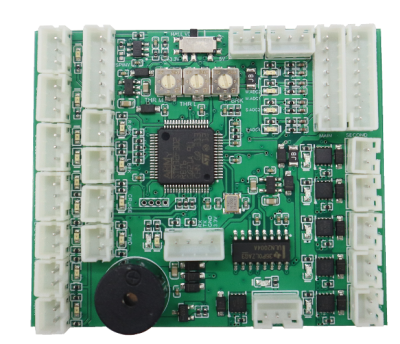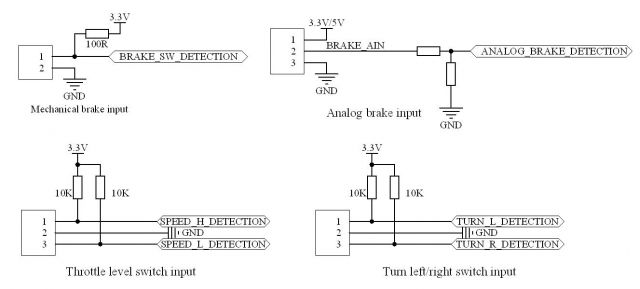Adapter V3 manual
//Editing, will be finished soon.
The V3 adapter is designed to make wiring and configurating more conveniently and intuitively.
By placed LEDs for each port, input and output, it will be the most easy way to verify and diagnosis your wiring, Even the analog throttle input and output!
And by make two simple calibrations (throttle and optional analogy brake input), the configurations on the VESC tool can be simply import a app-config file we provided instead.
Also we changed all the out put MOSFETs to hi-side switch, this is more convenient to use co-ground lights, which is popular in the market.
Size: 63 x 53 x 12.5 mm
This manual is based on Ubox V2 dual, for the other VESCs, the conceptions are the same.
Features
- Horn, head light, turn light, brake & rear light, and reverse light support.
- All FETs are hi-side PMOS, support co-ground lights.
- High, middle, low, 3 level throttle support.
- Motor reverse and cruise support.
- Buzzer to prompt turn and settings.
- Support both hall brake and mechanical brake input.
- Throttle current monitor, clear the VESC throttle ADC1 immediately when the throttle's '-' wire broken, ignores the pull-upped throttle input.
- Two/one wheel drive support.
- Convert 5V throttle and analog brake input signal to 3.3V range, no harm to VESC.
Wiring
[pictured needed]
- Mechanical brake, light, horn, reverse and cruise are actually switches, we don't need to distinguish the two wires of each switch.
- The turn left/right switch and throttle level switch, they usually has three wires, the neutral wire is the one which can be switched on/off to other wires, so if you are not sure the wire orders, use a multimeter to test them to find the neutral wire first, then know what the rest two wires are.
- Usually, hand bar throttle or thumb throttle have three wires: black, red, green, corresponding to GND, 5V, throttle output.
- Users can also use these type of throttles to make ADC(analog) brake, in Adapter V2, the ADC brake signal is transferred to VESC's ADC2 pin.
- The second VESC ADC PORT is for two wheel drive config, if you have one wheel drive only, connect MAIN PORT to VESC.
- Adapter need a 5V and 12V power source, the 5V is get from VESC ADC port, users need to connect a 12V power source to adapter's 12V socket, for Ubox V2 connect to its FAN socket.
- The rear and brake light, usually comes with three wires in common ground connection mode, the two lights share one GND. Connect the positive(anode) wire of rear light to 12V, and brake light's to Brake light+, and their negative(cathode) wire to GND.
- The other lights and horn are also high side switched, so connect the positive(anode) wire to the function pin, and the negative(cathode) wire to the pin to the 'G' pin.
- For Ubox single 75V, the extra NRF port is not available, or for the other VESCs without NRF port (some vendor referred as second UART), if the cruise and reverse functions are not needed, the TX and RX pin from the 8 pin port can connect to VESC Bluetooth by pick out the wires from the cable. Or you can refer to this small kit : the single vesc UART port seperator:https://spintend.com/collections/diy-tools-and-accessory/products/single-vesc-uart-port-seperator
The throttle, brake , their switch and potentionmeters
Some ebike/escooters have 3 level throttles, VESC does not support 3 level.
Most throttle working on 5V, and output voltage up to 4.2V, VESC can only accept ADC input within 3.3V (3.44V for some hard ware version).
VESC supports analog brake (variable/propotional) input to its ADC2, common ebike/escooter only provide a electronic switch attached to mechanical brake.
The adapter V3 do these translating jobs, makes VESC a full funtional ebike/scooter controller.
The adapter V3 divide the up to 5V throttle input, remap it to 3.3V levels, send to VESC ADC1. So do the analog brake input, remap it, send to VESC ADC2, if there is any mechanical brake switch being triggered, adapter V3 send the brake potentiometer's voltage to the ADC2 instead.
[picture needed]
The potentiometers are increase clockwise and decrease counterclockwise.
throttle and brake power supply
If your throttle can only accept 3.3V supply, set the ‘HALL VDD’ switch to '3.3V' side. Otherwise set it to '5V'. The analog brake port shares this supply too.
Throttle potentiometers
Adapter V2 supports three level throttles, the High level is equal to the throttle handle in put. The middle and low level are remapped from throttle handle input according to the 'THR M' and 'THR L' potentiometer's positions. The remap range is from 0 to 100%.
If you are not connect a three level throttle switch to adapter, in case you don't have it or don't need it, the default throttle level is middle, so adjust the 'THR M' potentiometer to its maximum position (clockwise), let the adapter not shrink the original throttle to the VESC.
Brake potentiometer
Mechanical brake have a electronic switch, to tell ESC to stop driving, some ESC can then do regenerative braking.
When trigger the mechanical brake switch, adapter V3 will assist it with regenerative brake automatically, the regenerative brake strength is according to the 'BRK' potentiometer, from 0 to 100%. Set it to its maximum position when do the input setup on the VESC tool.
Analog/variable brake
When no actions happened from mechanical brake(no braking), adapter V3 will conduct the analog voltage from "ABRK" to the VESC ADC2. There for to support the analog/variable brake.
What if I don't want a regenerative brake?
So the ADC2 input is no needed for VESC, set the APP mode to "Current", set to "Current Reverse Button" mode if you need a reverse function.



